IPM: Project Governance Plan for East Timor Solar Project, University
VerifiedAdded on 2022/08/27
|12
|2975
|16
Report
AI Summary
This report outlines a project governance plan for the East Timor Solar project, emphasizing effective tracking and monitoring of project progress. It evaluates methods for tracking cost and schedule, recommending the Earned Value Analysis (EVA) approach due to its quantitative data analysis advantages. The report details the structure of project reports, advocating for concise, statistical-focused content to facilitate stakeholder understanding and efficient communication via email and secure storage in Google Docs. It also specifies the frequency of Project Governance Board meetings, recommending sessions every three weeks to address project issues and risks, with a focus on comprehensive reporting and decision-making to ensure project success. The report justifies the chosen methods and reporting strategies, considering the international context and the need for streamlined communication.
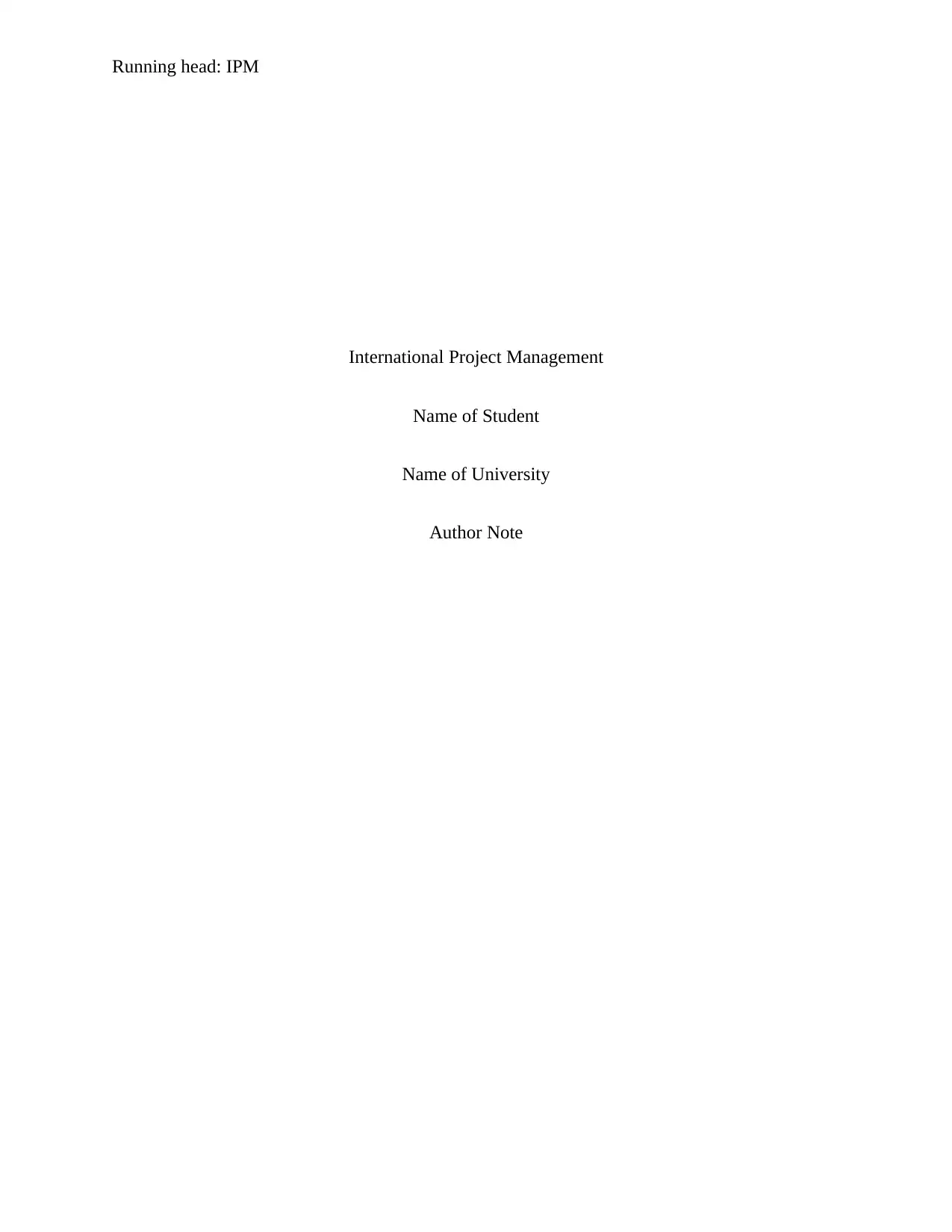
Running head: IPM
International Project Management
Name of Student
Name of University
Author Note
International Project Management
Name of Student
Name of University
Author Note
Paraphrase This Document
Need a fresh take? Get an instant paraphrase of this document with our AI Paraphraser
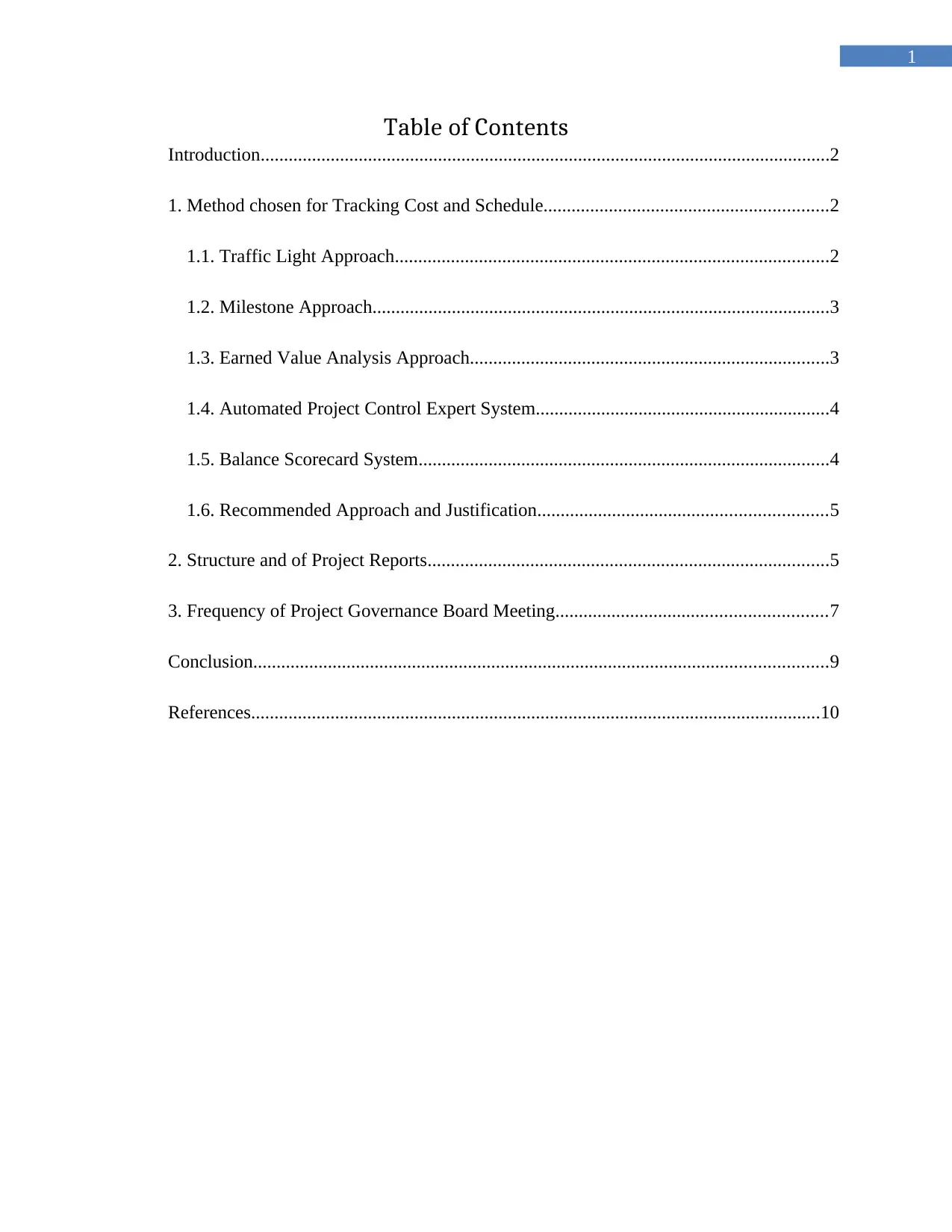
1
Table of Contents
Introduction..........................................................................................................................2
1. Method chosen for Tracking Cost and Schedule.............................................................2
1.1. Traffic Light Approach.............................................................................................2
1.2. Milestone Approach..................................................................................................3
1.3. Earned Value Analysis Approach.............................................................................3
1.4. Automated Project Control Expert System...............................................................4
1.5. Balance Scorecard System........................................................................................4
1.6. Recommended Approach and Justification..............................................................5
2. Structure and of Project Reports......................................................................................5
3. Frequency of Project Governance Board Meeting..........................................................7
Conclusion...........................................................................................................................9
References..........................................................................................................................10
Table of Contents
Introduction..........................................................................................................................2
1. Method chosen for Tracking Cost and Schedule.............................................................2
1.1. Traffic Light Approach.............................................................................................2
1.2. Milestone Approach..................................................................................................3
1.3. Earned Value Analysis Approach.............................................................................3
1.4. Automated Project Control Expert System...............................................................4
1.5. Balance Scorecard System........................................................................................4
1.6. Recommended Approach and Justification..............................................................5
2. Structure and of Project Reports......................................................................................5
3. Frequency of Project Governance Board Meeting..........................................................7
Conclusion...........................................................................................................................9
References..........................................................................................................................10
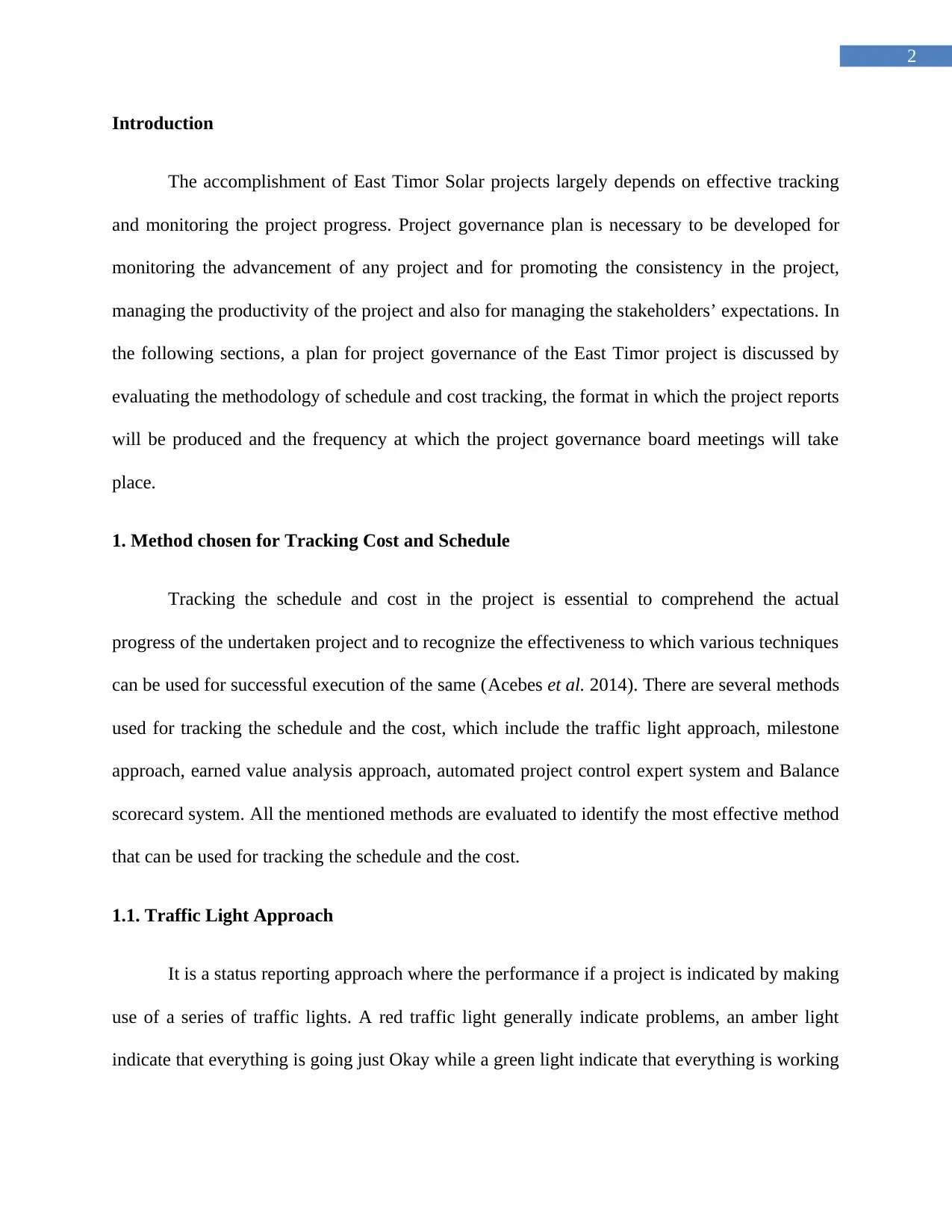
2
Introduction
The accomplishment of East Timor Solar projects largely depends on effective tracking
and monitoring the project progress. Project governance plan is necessary to be developed for
monitoring the advancement of any project and for promoting the consistency in the project,
managing the productivity of the project and also for managing the stakeholders’ expectations. In
the following sections, a plan for project governance of the East Timor project is discussed by
evaluating the methodology of schedule and cost tracking, the format in which the project reports
will be produced and the frequency at which the project governance board meetings will take
place.
1. Method chosen for Tracking Cost and Schedule
Tracking the schedule and cost in the project is essential to comprehend the actual
progress of the undertaken project and to recognize the effectiveness to which various techniques
can be used for successful execution of the same (Acebes et al. 2014). There are several methods
used for tracking the schedule and the cost, which include the traffic light approach, milestone
approach, earned value analysis approach, automated project control expert system and Balance
scorecard system. All the mentioned methods are evaluated to identify the most effective method
that can be used for tracking the schedule and the cost.
1.1. Traffic Light Approach
It is a status reporting approach where the performance if a project is indicated by making
use of a series of traffic lights. A red traffic light generally indicate problems, an amber light
indicate that everything is going just Okay while a green light indicate that everything is working
Introduction
The accomplishment of East Timor Solar projects largely depends on effective tracking
and monitoring the project progress. Project governance plan is necessary to be developed for
monitoring the advancement of any project and for promoting the consistency in the project,
managing the productivity of the project and also for managing the stakeholders’ expectations. In
the following sections, a plan for project governance of the East Timor project is discussed by
evaluating the methodology of schedule and cost tracking, the format in which the project reports
will be produced and the frequency at which the project governance board meetings will take
place.
1. Method chosen for Tracking Cost and Schedule
Tracking the schedule and cost in the project is essential to comprehend the actual
progress of the undertaken project and to recognize the effectiveness to which various techniques
can be used for successful execution of the same (Acebes et al. 2014). There are several methods
used for tracking the schedule and the cost, which include the traffic light approach, milestone
approach, earned value analysis approach, automated project control expert system and Balance
scorecard system. All the mentioned methods are evaluated to identify the most effective method
that can be used for tracking the schedule and the cost.
1.1. Traffic Light Approach
It is a status reporting approach where the performance if a project is indicated by making
use of a series of traffic lights. A red traffic light generally indicate problems, an amber light
indicate that everything is going just Okay while a green light indicate that everything is working
⊘ This is a preview!⊘
Do you want full access?
Subscribe today to unlock all pages.

Trusted by 1+ million students worldwide
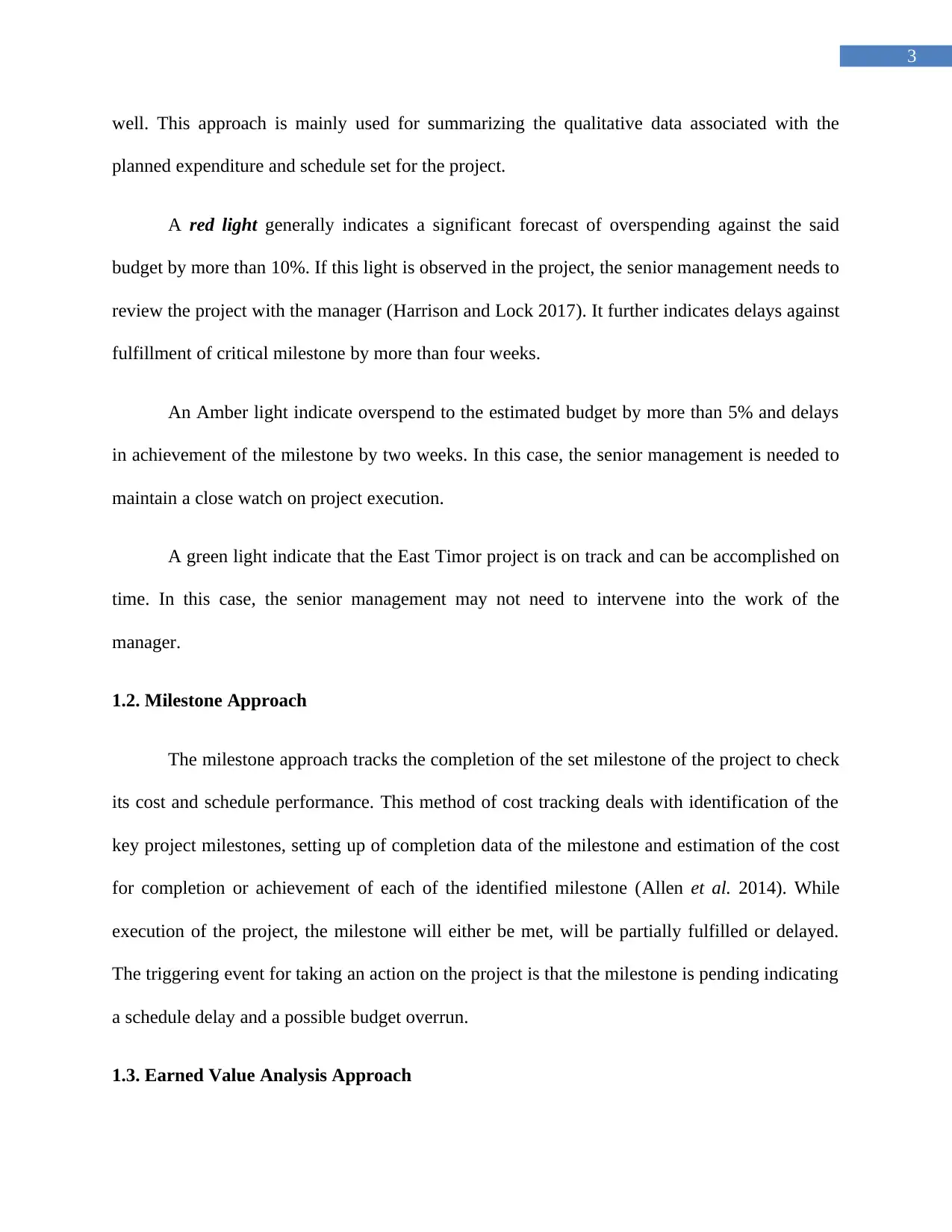
3
well. This approach is mainly used for summarizing the qualitative data associated with the
planned expenditure and schedule set for the project.
A red light generally indicates a significant forecast of overspending against the said
budget by more than 10%. If this light is observed in the project, the senior management needs to
review the project with the manager (Harrison and Lock 2017). It further indicates delays against
fulfillment of critical milestone by more than four weeks.
An Amber light indicate overspend to the estimated budget by more than 5% and delays
in achievement of the milestone by two weeks. In this case, the senior management is needed to
maintain a close watch on project execution.
A green light indicate that the East Timor project is on track and can be accomplished on
time. In this case, the senior management may not need to intervene into the work of the
manager.
1.2. Milestone Approach
The milestone approach tracks the completion of the set milestone of the project to check
its cost and schedule performance. This method of cost tracking deals with identification of the
key project milestones, setting up of completion data of the milestone and estimation of the cost
for completion or achievement of each of the identified milestone (Allen et al. 2014). While
execution of the project, the milestone will either be met, will be partially fulfilled or delayed.
The triggering event for taking an action on the project is that the milestone is pending indicating
a schedule delay and a possible budget overrun.
1.3. Earned Value Analysis Approach
well. This approach is mainly used for summarizing the qualitative data associated with the
planned expenditure and schedule set for the project.
A red light generally indicates a significant forecast of overspending against the said
budget by more than 10%. If this light is observed in the project, the senior management needs to
review the project with the manager (Harrison and Lock 2017). It further indicates delays against
fulfillment of critical milestone by more than four weeks.
An Amber light indicate overspend to the estimated budget by more than 5% and delays
in achievement of the milestone by two weeks. In this case, the senior management is needed to
maintain a close watch on project execution.
A green light indicate that the East Timor project is on track and can be accomplished on
time. In this case, the senior management may not need to intervene into the work of the
manager.
1.2. Milestone Approach
The milestone approach tracks the completion of the set milestone of the project to check
its cost and schedule performance. This method of cost tracking deals with identification of the
key project milestones, setting up of completion data of the milestone and estimation of the cost
for completion or achievement of each of the identified milestone (Allen et al. 2014). While
execution of the project, the milestone will either be met, will be partially fulfilled or delayed.
The triggering event for taking an action on the project is that the milestone is pending indicating
a schedule delay and a possible budget overrun.
1.3. Earned Value Analysis Approach
Paraphrase This Document
Need a fresh take? Get an instant paraphrase of this document with our AI Paraphraser
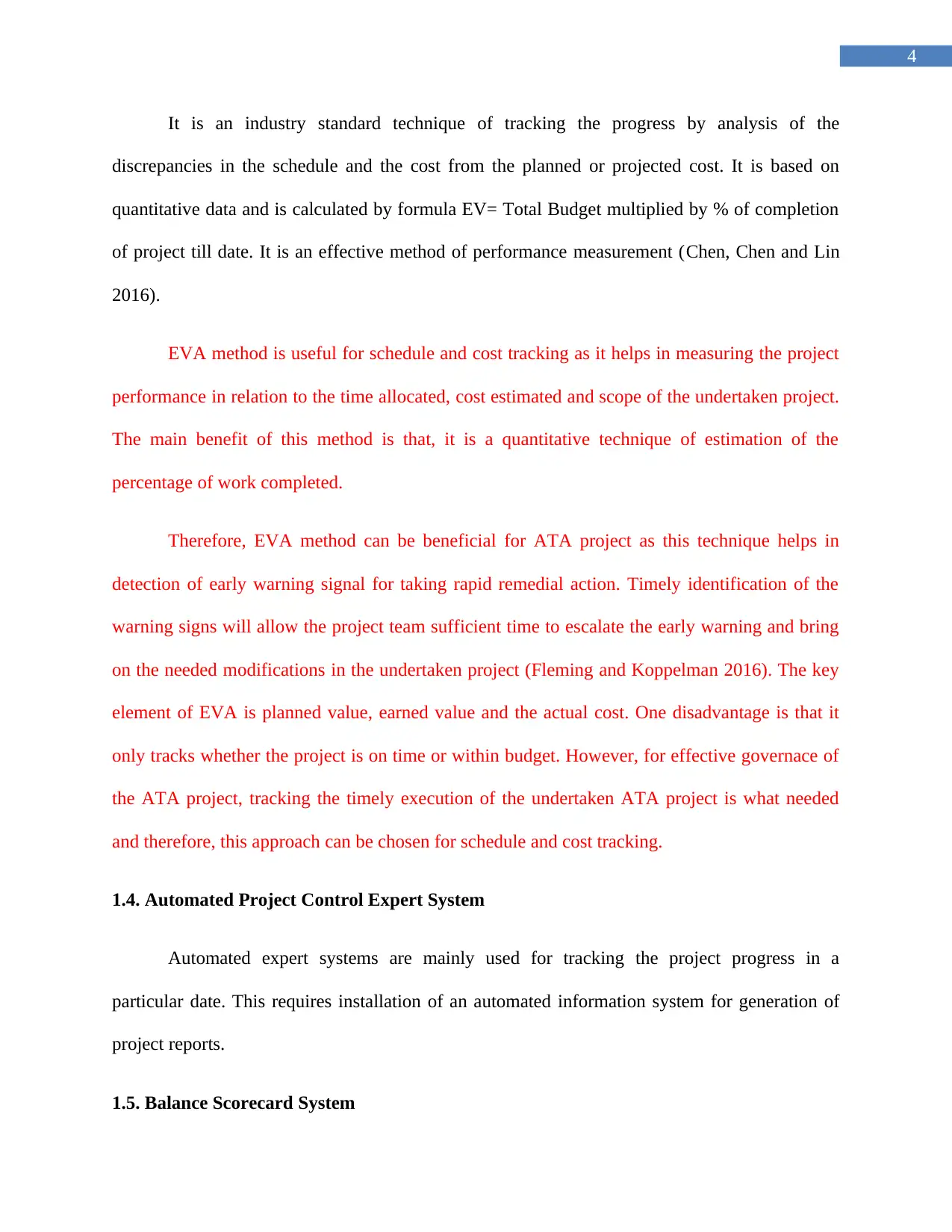
4
It is an industry standard technique of tracking the progress by analysis of the
discrepancies in the schedule and the cost from the planned or projected cost. It is based on
quantitative data and is calculated by formula EV= Total Budget multiplied by % of completion
of project till date. It is an effective method of performance measurement (Chen, Chen and Lin
2016).
EVA method is useful for schedule and cost tracking as it helps in measuring the project
performance in relation to the time allocated, cost estimated and scope of the undertaken project.
The main benefit of this method is that, it is a quantitative technique of estimation of the
percentage of work completed.
Therefore, EVA method can be beneficial for ATA project as this technique helps in
detection of early warning signal for taking rapid remedial action. Timely identification of the
warning signs will allow the project team sufficient time to escalate the early warning and bring
on the needed modifications in the undertaken project (Fleming and Koppelman 2016). The key
element of EVA is planned value, earned value and the actual cost. One disadvantage is that it
only tracks whether the project is on time or within budget. However, for effective governace of
the ATA project, tracking the timely execution of the undertaken ATA project is what needed
and therefore, this approach can be chosen for schedule and cost tracking.
1.4. Automated Project Control Expert System
Automated expert systems are mainly used for tracking the project progress in a
particular date. This requires installation of an automated information system for generation of
project reports.
1.5. Balance Scorecard System
It is an industry standard technique of tracking the progress by analysis of the
discrepancies in the schedule and the cost from the planned or projected cost. It is based on
quantitative data and is calculated by formula EV= Total Budget multiplied by % of completion
of project till date. It is an effective method of performance measurement (Chen, Chen and Lin
2016).
EVA method is useful for schedule and cost tracking as it helps in measuring the project
performance in relation to the time allocated, cost estimated and scope of the undertaken project.
The main benefit of this method is that, it is a quantitative technique of estimation of the
percentage of work completed.
Therefore, EVA method can be beneficial for ATA project as this technique helps in
detection of early warning signal for taking rapid remedial action. Timely identification of the
warning signs will allow the project team sufficient time to escalate the early warning and bring
on the needed modifications in the undertaken project (Fleming and Koppelman 2016). The key
element of EVA is planned value, earned value and the actual cost. One disadvantage is that it
only tracks whether the project is on time or within budget. However, for effective governace of
the ATA project, tracking the timely execution of the undertaken ATA project is what needed
and therefore, this approach can be chosen for schedule and cost tracking.
1.4. Automated Project Control Expert System
Automated expert systems are mainly used for tracking the project progress in a
particular date. This requires installation of an automated information system for generation of
project reports.
1.5. Balance Scorecard System
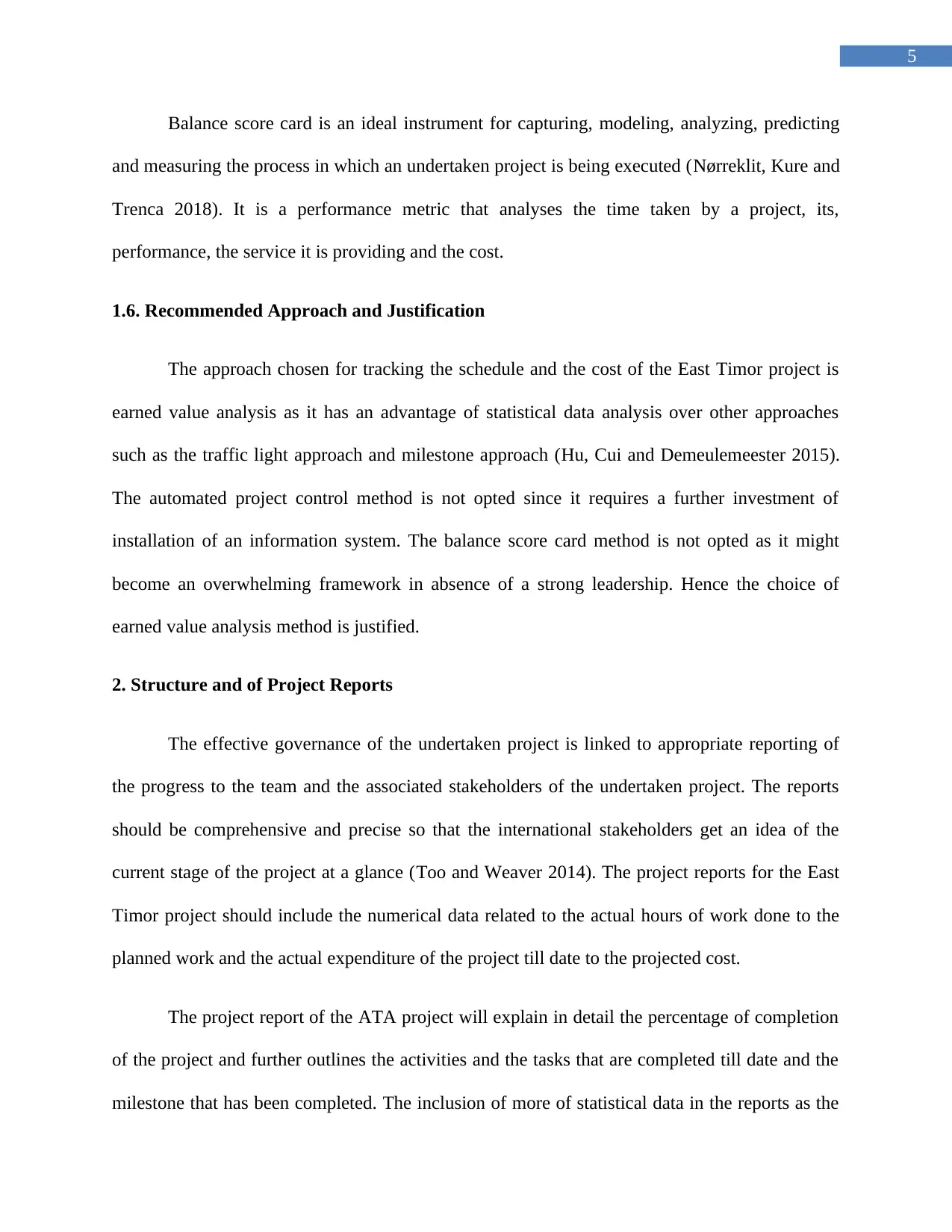
5
Balance score card is an ideal instrument for capturing, modeling, analyzing, predicting
and measuring the process in which an undertaken project is being executed (Nørreklit, Kure and
Trenca 2018). It is a performance metric that analyses the time taken by a project, its,
performance, the service it is providing and the cost.
1.6. Recommended Approach and Justification
The approach chosen for tracking the schedule and the cost of the East Timor project is
earned value analysis as it has an advantage of statistical data analysis over other approaches
such as the traffic light approach and milestone approach (Hu, Cui and Demeulemeester 2015).
The automated project control method is not opted since it requires a further investment of
installation of an information system. The balance score card method is not opted as it might
become an overwhelming framework in absence of a strong leadership. Hence the choice of
earned value analysis method is justified.
2. Structure and of Project Reports
The effective governance of the undertaken project is linked to appropriate reporting of
the progress to the team and the associated stakeholders of the undertaken project. The reports
should be comprehensive and precise so that the international stakeholders get an idea of the
current stage of the project at a glance (Too and Weaver 2014). The project reports for the East
Timor project should include the numerical data related to the actual hours of work done to the
planned work and the actual expenditure of the project till date to the projected cost.
The project report of the ATA project will explain in detail the percentage of completion
of the project and further outlines the activities and the tasks that are completed till date and the
milestone that has been completed. The inclusion of more of statistical data in the reports as the
Balance score card is an ideal instrument for capturing, modeling, analyzing, predicting
and measuring the process in which an undertaken project is being executed (Nørreklit, Kure and
Trenca 2018). It is a performance metric that analyses the time taken by a project, its,
performance, the service it is providing and the cost.
1.6. Recommended Approach and Justification
The approach chosen for tracking the schedule and the cost of the East Timor project is
earned value analysis as it has an advantage of statistical data analysis over other approaches
such as the traffic light approach and milestone approach (Hu, Cui and Demeulemeester 2015).
The automated project control method is not opted since it requires a further investment of
installation of an information system. The balance score card method is not opted as it might
become an overwhelming framework in absence of a strong leadership. Hence the choice of
earned value analysis method is justified.
2. Structure and of Project Reports
The effective governance of the undertaken project is linked to appropriate reporting of
the progress to the team and the associated stakeholders of the undertaken project. The reports
should be comprehensive and precise so that the international stakeholders get an idea of the
current stage of the project at a glance (Too and Weaver 2014). The project reports for the East
Timor project should include the numerical data related to the actual hours of work done to the
planned work and the actual expenditure of the project till date to the projected cost.
The project report of the ATA project will explain in detail the percentage of completion
of the project and further outlines the activities and the tasks that are completed till date and the
milestone that has been completed. The inclusion of more of statistical data in the reports as the
⊘ This is a preview!⊘
Do you want full access?
Subscribe today to unlock all pages.

Trusted by 1+ million students worldwide
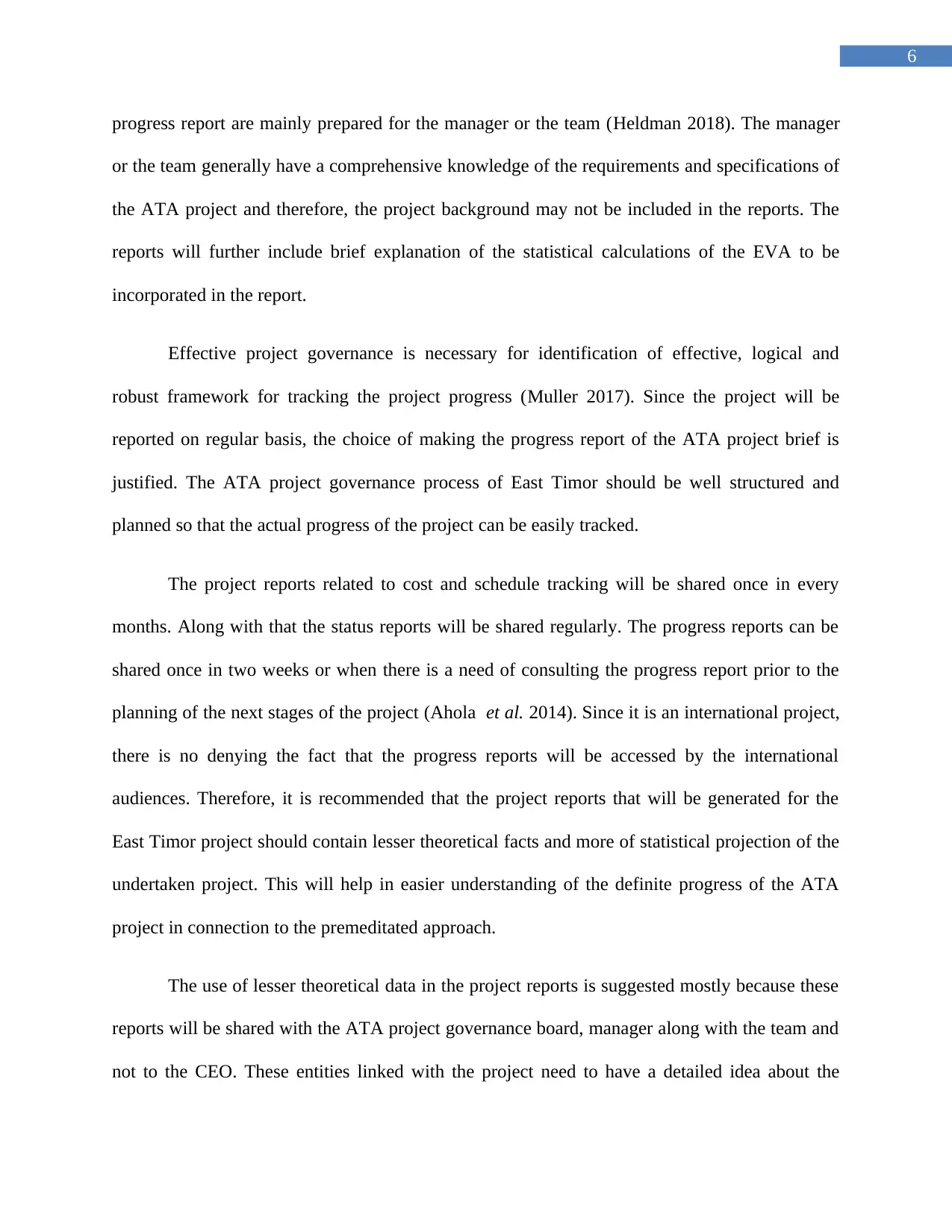
6
progress report are mainly prepared for the manager or the team (Heldman 2018). The manager
or the team generally have a comprehensive knowledge of the requirements and specifications of
the ATA project and therefore, the project background may not be included in the reports. The
reports will further include brief explanation of the statistical calculations of the EVA to be
incorporated in the report.
Effective project governance is necessary for identification of effective, logical and
robust framework for tracking the project progress (Muller 2017). Since the project will be
reported on regular basis, the choice of making the progress report of the ATA project brief is
justified. The ATA project governance process of East Timor should be well structured and
planned so that the actual progress of the project can be easily tracked.
The project reports related to cost and schedule tracking will be shared once in every
months. Along with that the status reports will be shared regularly. The progress reports can be
shared once in two weeks or when there is a need of consulting the progress report prior to the
planning of the next stages of the project (Ahola et al. 2014). Since it is an international project,
there is no denying the fact that the progress reports will be accessed by the international
audiences. Therefore, it is recommended that the project reports that will be generated for the
East Timor project should contain lesser theoretical facts and more of statistical projection of the
undertaken project. This will help in easier understanding of the definite progress of the ATA
project in connection to the premeditated approach.
The use of lesser theoretical data in the project reports is suggested mostly because these
reports will be shared with the ATA project governance board, manager along with the team and
not to the CEO. These entities linked with the project need to have a detailed idea about the
progress report are mainly prepared for the manager or the team (Heldman 2018). The manager
or the team generally have a comprehensive knowledge of the requirements and specifications of
the ATA project and therefore, the project background may not be included in the reports. The
reports will further include brief explanation of the statistical calculations of the EVA to be
incorporated in the report.
Effective project governance is necessary for identification of effective, logical and
robust framework for tracking the project progress (Muller 2017). Since the project will be
reported on regular basis, the choice of making the progress report of the ATA project brief is
justified. The ATA project governance process of East Timor should be well structured and
planned so that the actual progress of the project can be easily tracked.
The project reports related to cost and schedule tracking will be shared once in every
months. Along with that the status reports will be shared regularly. The progress reports can be
shared once in two weeks or when there is a need of consulting the progress report prior to the
planning of the next stages of the project (Ahola et al. 2014). Since it is an international project,
there is no denying the fact that the progress reports will be accessed by the international
audiences. Therefore, it is recommended that the project reports that will be generated for the
East Timor project should contain lesser theoretical facts and more of statistical projection of the
undertaken project. This will help in easier understanding of the definite progress of the ATA
project in connection to the premeditated approach.
The use of lesser theoretical data in the project reports is suggested mostly because these
reports will be shared with the ATA project governance board, manager along with the team and
not to the CEO. These entities linked with the project need to have a detailed idea about the
Paraphrase This Document
Need a fresh take? Get an instant paraphrase of this document with our AI Paraphraser
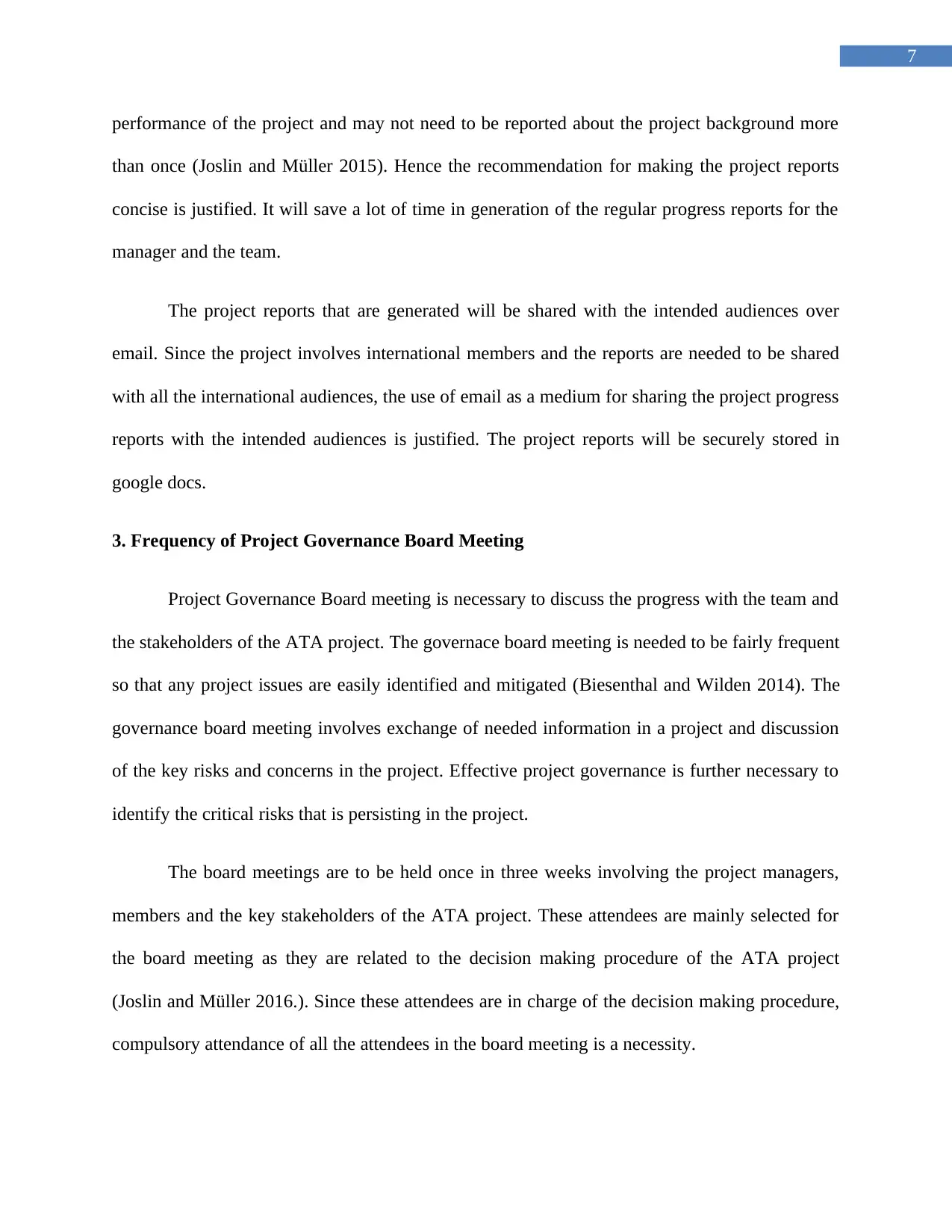
7
performance of the project and may not need to be reported about the project background more
than once (Joslin and Müller 2015). Hence the recommendation for making the project reports
concise is justified. It will save a lot of time in generation of the regular progress reports for the
manager and the team.
The project reports that are generated will be shared with the intended audiences over
email. Since the project involves international members and the reports are needed to be shared
with all the international audiences, the use of email as a medium for sharing the project progress
reports with the intended audiences is justified. The project reports will be securely stored in
google docs.
3. Frequency of Project Governance Board Meeting
Project Governance Board meeting is necessary to discuss the progress with the team and
the stakeholders of the ATA project. The governace board meeting is needed to be fairly frequent
so that any project issues are easily identified and mitigated (Biesenthal and Wilden 2014). The
governance board meeting involves exchange of needed information in a project and discussion
of the key risks and concerns in the project. Effective project governance is further necessary to
identify the critical risks that is persisting in the project.
The board meetings are to be held once in three weeks involving the project managers,
members and the key stakeholders of the ATA project. These attendees are mainly selected for
the board meeting as they are related to the decision making procedure of the ATA project
(Joslin and Müller 2016.). Since these attendees are in charge of the decision making procedure,
compulsory attendance of all the attendees in the board meeting is a necessity.
performance of the project and may not need to be reported about the project background more
than once (Joslin and Müller 2015). Hence the recommendation for making the project reports
concise is justified. It will save a lot of time in generation of the regular progress reports for the
manager and the team.
The project reports that are generated will be shared with the intended audiences over
email. Since the project involves international members and the reports are needed to be shared
with all the international audiences, the use of email as a medium for sharing the project progress
reports with the intended audiences is justified. The project reports will be securely stored in
google docs.
3. Frequency of Project Governance Board Meeting
Project Governance Board meeting is necessary to discuss the progress with the team and
the stakeholders of the ATA project. The governace board meeting is needed to be fairly frequent
so that any project issues are easily identified and mitigated (Biesenthal and Wilden 2014). The
governance board meeting involves exchange of needed information in a project and discussion
of the key risks and concerns in the project. Effective project governance is further necessary to
identify the critical risks that is persisting in the project.
The board meetings are to be held once in three weeks involving the project managers,
members and the key stakeholders of the ATA project. These attendees are mainly selected for
the board meeting as they are related to the decision making procedure of the ATA project
(Joslin and Müller 2016.). Since these attendees are in charge of the decision making procedure,
compulsory attendance of all the attendees in the board meeting is a necessity.
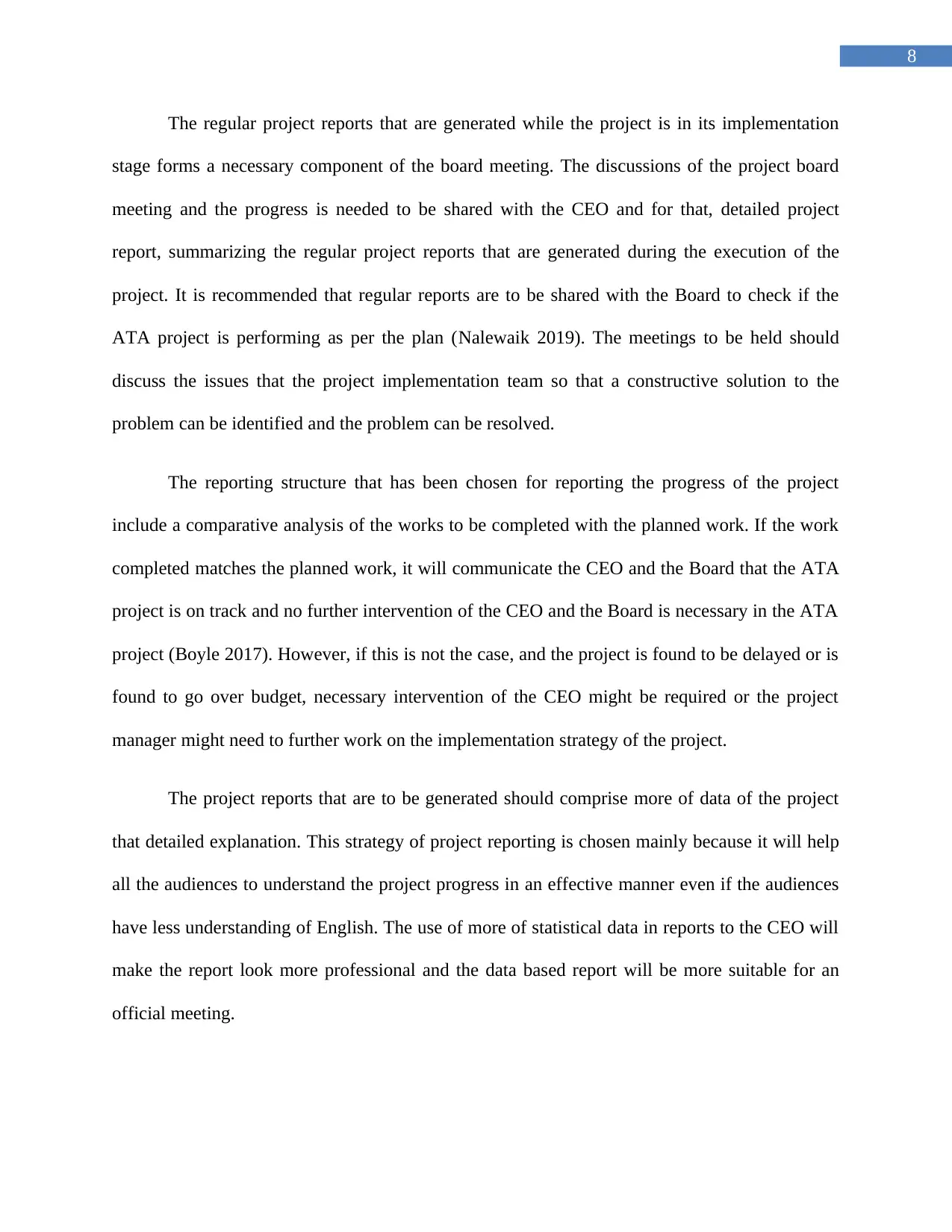
8
The regular project reports that are generated while the project is in its implementation
stage forms a necessary component of the board meeting. The discussions of the project board
meeting and the progress is needed to be shared with the CEO and for that, detailed project
report, summarizing the regular project reports that are generated during the execution of the
project. It is recommended that regular reports are to be shared with the Board to check if the
ATA project is performing as per the plan (Nalewaik 2019). The meetings to be held should
discuss the issues that the project implementation team so that a constructive solution to the
problem can be identified and the problem can be resolved.
The reporting structure that has been chosen for reporting the progress of the project
include a comparative analysis of the works to be completed with the planned work. If the work
completed matches the planned work, it will communicate the CEO and the Board that the ATA
project is on track and no further intervention of the CEO and the Board is necessary in the ATA
project (Boyle 2017). However, if this is not the case, and the project is found to be delayed or is
found to go over budget, necessary intervention of the CEO might be required or the project
manager might need to further work on the implementation strategy of the project.
The project reports that are to be generated should comprise more of data of the project
that detailed explanation. This strategy of project reporting is chosen mainly because it will help
all the audiences to understand the project progress in an effective manner even if the audiences
have less understanding of English. The use of more of statistical data in reports to the CEO will
make the report look more professional and the data based report will be more suitable for an
official meeting.
The regular project reports that are generated while the project is in its implementation
stage forms a necessary component of the board meeting. The discussions of the project board
meeting and the progress is needed to be shared with the CEO and for that, detailed project
report, summarizing the regular project reports that are generated during the execution of the
project. It is recommended that regular reports are to be shared with the Board to check if the
ATA project is performing as per the plan (Nalewaik 2019). The meetings to be held should
discuss the issues that the project implementation team so that a constructive solution to the
problem can be identified and the problem can be resolved.
The reporting structure that has been chosen for reporting the progress of the project
include a comparative analysis of the works to be completed with the planned work. If the work
completed matches the planned work, it will communicate the CEO and the Board that the ATA
project is on track and no further intervention of the CEO and the Board is necessary in the ATA
project (Boyle 2017). However, if this is not the case, and the project is found to be delayed or is
found to go over budget, necessary intervention of the CEO might be required or the project
manager might need to further work on the implementation strategy of the project.
The project reports that are to be generated should comprise more of data of the project
that detailed explanation. This strategy of project reporting is chosen mainly because it will help
all the audiences to understand the project progress in an effective manner even if the audiences
have less understanding of English. The use of more of statistical data in reports to the CEO will
make the report look more professional and the data based report will be more suitable for an
official meeting.
⊘ This is a preview!⊘
Do you want full access?
Subscribe today to unlock all pages.

Trusted by 1+ million students worldwide
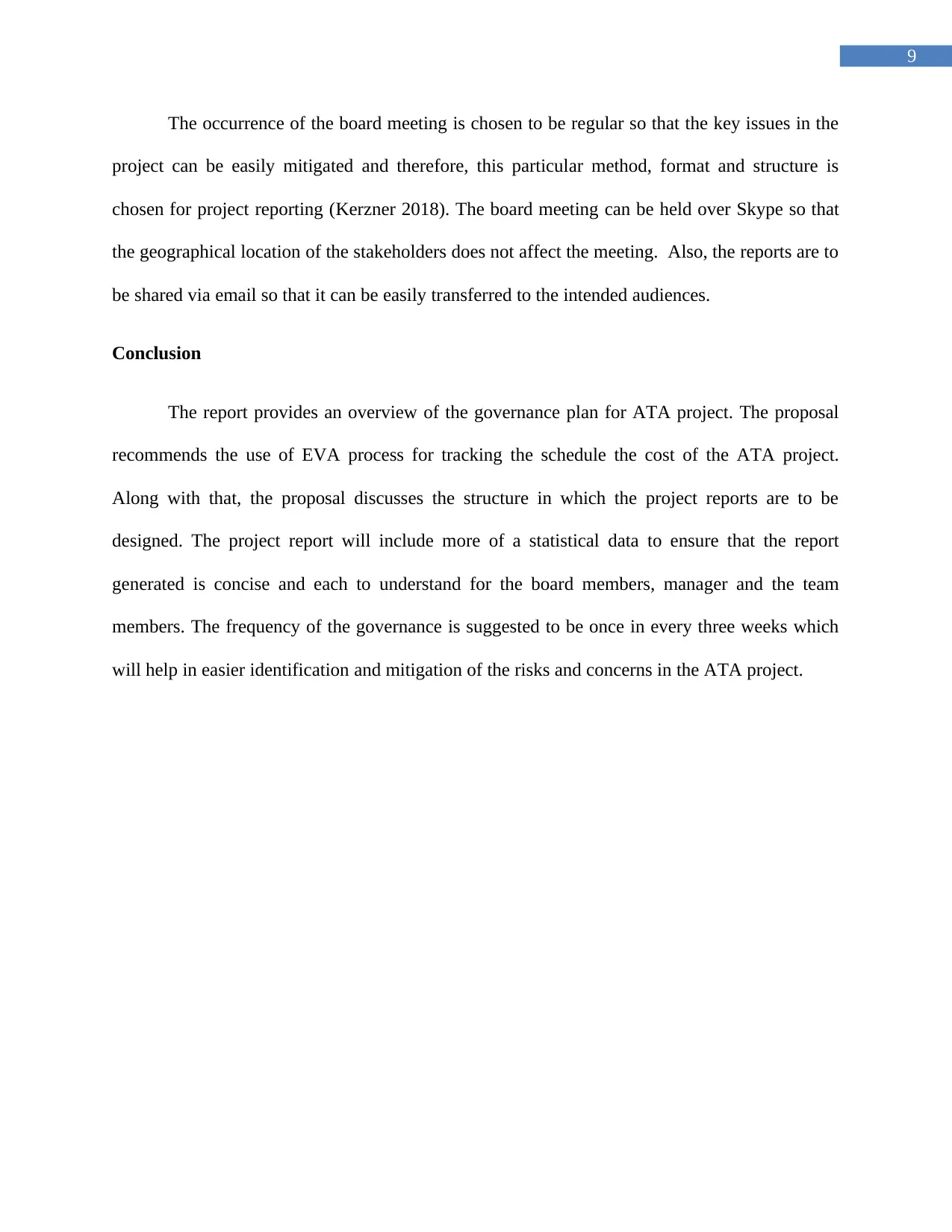
9
The occurrence of the board meeting is chosen to be regular so that the key issues in the
project can be easily mitigated and therefore, this particular method, format and structure is
chosen for project reporting (Kerzner 2018). The board meeting can be held over Skype so that
the geographical location of the stakeholders does not affect the meeting. Also, the reports are to
be shared via email so that it can be easily transferred to the intended audiences.
Conclusion
The report provides an overview of the governance plan for ATA project. The proposal
recommends the use of EVA process for tracking the schedule the cost of the ATA project.
Along with that, the proposal discusses the structure in which the project reports are to be
designed. The project report will include more of a statistical data to ensure that the report
generated is concise and each to understand for the board members, manager and the team
members. The frequency of the governance is suggested to be once in every three weeks which
will help in easier identification and mitigation of the risks and concerns in the ATA project.
The occurrence of the board meeting is chosen to be regular so that the key issues in the
project can be easily mitigated and therefore, this particular method, format and structure is
chosen for project reporting (Kerzner 2018). The board meeting can be held over Skype so that
the geographical location of the stakeholders does not affect the meeting. Also, the reports are to
be shared via email so that it can be easily transferred to the intended audiences.
Conclusion
The report provides an overview of the governance plan for ATA project. The proposal
recommends the use of EVA process for tracking the schedule the cost of the ATA project.
Along with that, the proposal discusses the structure in which the project reports are to be
designed. The project report will include more of a statistical data to ensure that the report
generated is concise and each to understand for the board members, manager and the team
members. The frequency of the governance is suggested to be once in every three weeks which
will help in easier identification and mitigation of the risks and concerns in the ATA project.
Paraphrase This Document
Need a fresh take? Get an instant paraphrase of this document with our AI Paraphraser
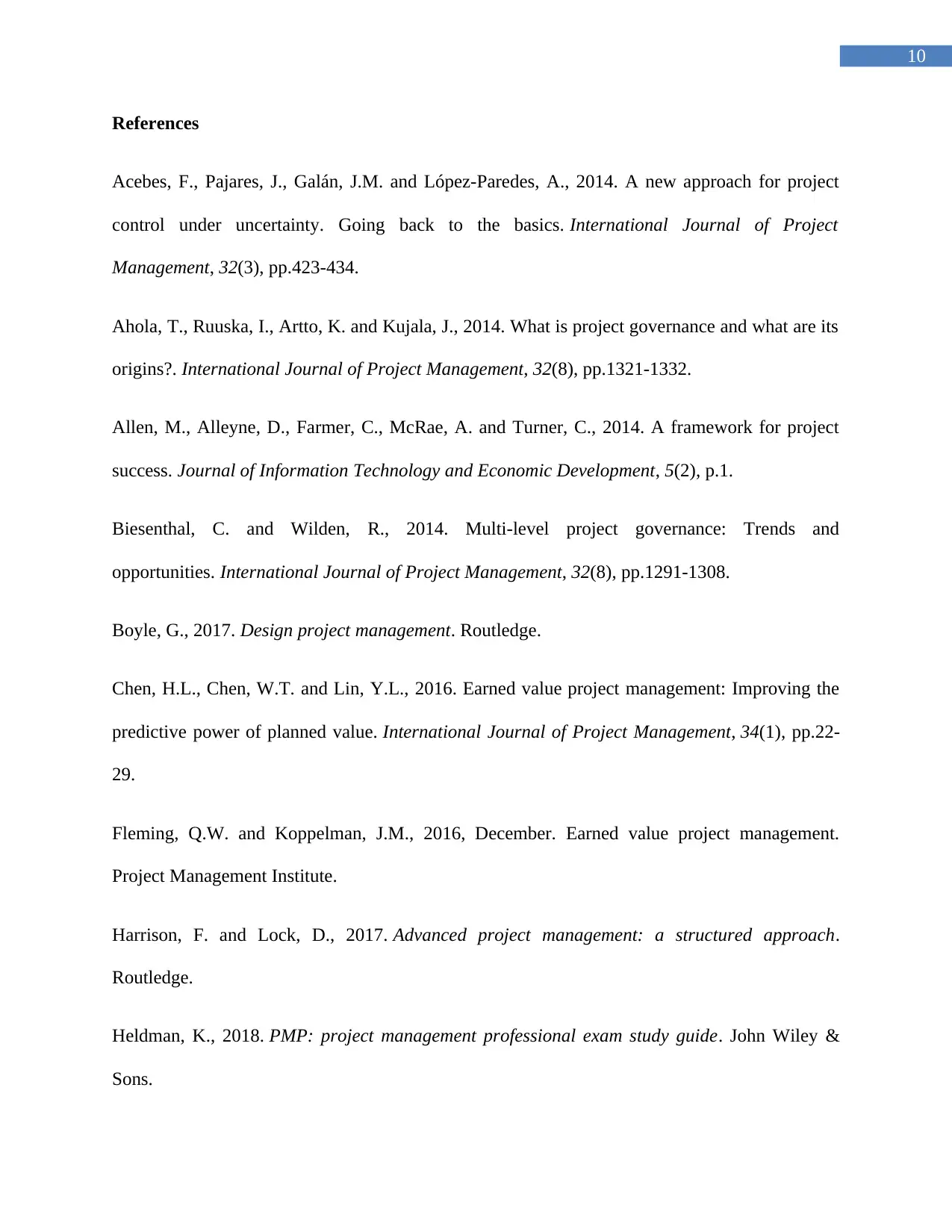
10
References
Acebes, F., Pajares, J., Galán, J.M. and López-Paredes, A., 2014. A new approach for project
control under uncertainty. Going back to the basics. International Journal of Project
Management, 32(3), pp.423-434.
Ahola, T., Ruuska, I., Artto, K. and Kujala, J., 2014. What is project governance and what are its
origins?. International Journal of Project Management, 32(8), pp.1321-1332.
Allen, M., Alleyne, D., Farmer, C., McRae, A. and Turner, C., 2014. A framework for project
success. Journal of Information Technology and Economic Development, 5(2), p.1.
Biesenthal, C. and Wilden, R., 2014. Multi-level project governance: Trends and
opportunities. International Journal of Project Management, 32(8), pp.1291-1308.
Boyle, G., 2017. Design project management. Routledge.
Chen, H.L., Chen, W.T. and Lin, Y.L., 2016. Earned value project management: Improving the
predictive power of planned value. International Journal of Project Management, 34(1), pp.22-
29.
Fleming, Q.W. and Koppelman, J.M., 2016, December. Earned value project management.
Project Management Institute.
Harrison, F. and Lock, D., 2017. Advanced project management: a structured approach.
Routledge.
Heldman, K., 2018. PMP: project management professional exam study guide. John Wiley &
Sons.
References
Acebes, F., Pajares, J., Galán, J.M. and López-Paredes, A., 2014. A new approach for project
control under uncertainty. Going back to the basics. International Journal of Project
Management, 32(3), pp.423-434.
Ahola, T., Ruuska, I., Artto, K. and Kujala, J., 2014. What is project governance and what are its
origins?. International Journal of Project Management, 32(8), pp.1321-1332.
Allen, M., Alleyne, D., Farmer, C., McRae, A. and Turner, C., 2014. A framework for project
success. Journal of Information Technology and Economic Development, 5(2), p.1.
Biesenthal, C. and Wilden, R., 2014. Multi-level project governance: Trends and
opportunities. International Journal of Project Management, 32(8), pp.1291-1308.
Boyle, G., 2017. Design project management. Routledge.
Chen, H.L., Chen, W.T. and Lin, Y.L., 2016. Earned value project management: Improving the
predictive power of planned value. International Journal of Project Management, 34(1), pp.22-
29.
Fleming, Q.W. and Koppelman, J.M., 2016, December. Earned value project management.
Project Management Institute.
Harrison, F. and Lock, D., 2017. Advanced project management: a structured approach.
Routledge.
Heldman, K., 2018. PMP: project management professional exam study guide. John Wiley &
Sons.
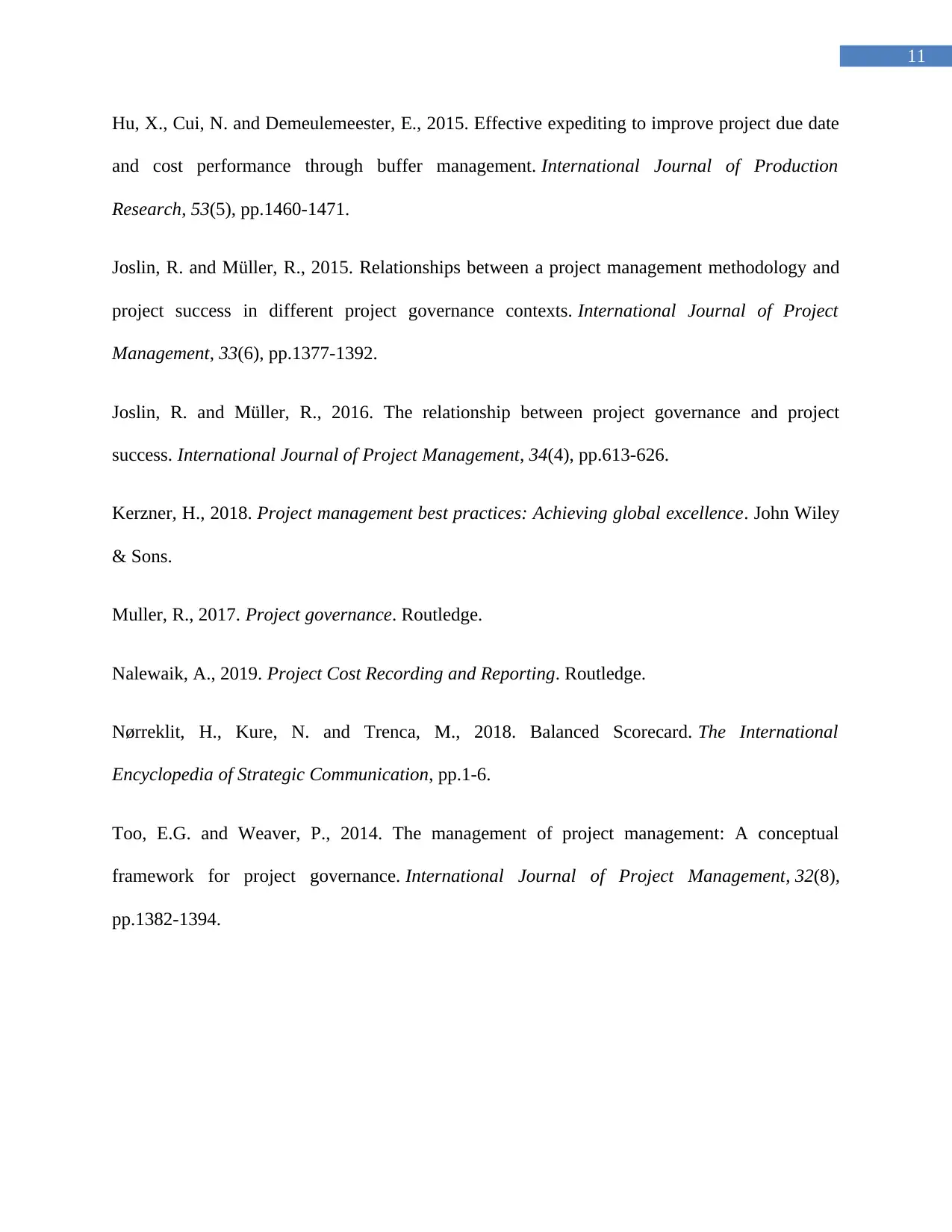
11
Hu, X., Cui, N. and Demeulemeester, E., 2015. Effective expediting to improve project due date
and cost performance through buffer management. International Journal of Production
Research, 53(5), pp.1460-1471.
Joslin, R. and Müller, R., 2015. Relationships between a project management methodology and
project success in different project governance contexts. International Journal of Project
Management, 33(6), pp.1377-1392.
Joslin, R. and Müller, R., 2016. The relationship between project governance and project
success. International Journal of Project Management, 34(4), pp.613-626.
Kerzner, H., 2018. Project management best practices: Achieving global excellence. John Wiley
& Sons.
Muller, R., 2017. Project governance. Routledge.
Nalewaik, A., 2019. Project Cost Recording and Reporting. Routledge.
Nørreklit, H., Kure, N. and Trenca, M., 2018. Balanced Scorecard. The International
Encyclopedia of Strategic Communication, pp.1-6.
Too, E.G. and Weaver, P., 2014. The management of project management: A conceptual
framework for project governance. International Journal of Project Management, 32(8),
pp.1382-1394.
Hu, X., Cui, N. and Demeulemeester, E., 2015. Effective expediting to improve project due date
and cost performance through buffer management. International Journal of Production
Research, 53(5), pp.1460-1471.
Joslin, R. and Müller, R., 2015. Relationships between a project management methodology and
project success in different project governance contexts. International Journal of Project
Management, 33(6), pp.1377-1392.
Joslin, R. and Müller, R., 2016. The relationship between project governance and project
success. International Journal of Project Management, 34(4), pp.613-626.
Kerzner, H., 2018. Project management best practices: Achieving global excellence. John Wiley
& Sons.
Muller, R., 2017. Project governance. Routledge.
Nalewaik, A., 2019. Project Cost Recording and Reporting. Routledge.
Nørreklit, H., Kure, N. and Trenca, M., 2018. Balanced Scorecard. The International
Encyclopedia of Strategic Communication, pp.1-6.
Too, E.G. and Weaver, P., 2014. The management of project management: A conceptual
framework for project governance. International Journal of Project Management, 32(8),
pp.1382-1394.
⊘ This is a preview!⊘
Do you want full access?
Subscribe today to unlock all pages.

Trusted by 1+ million students worldwide
1 out of 12
Your All-in-One AI-Powered Toolkit for Academic Success.
+13062052269
info@desklib.com
Available 24*7 on WhatsApp / Email
![[object Object]](/_next/static/media/star-bottom.7253800d.svg)
Unlock your academic potential
Copyright © 2020–2025 A2Z Services. All Rights Reserved. Developed and managed by ZUCOL.


